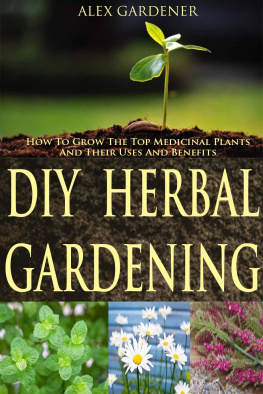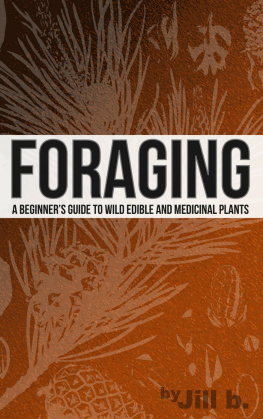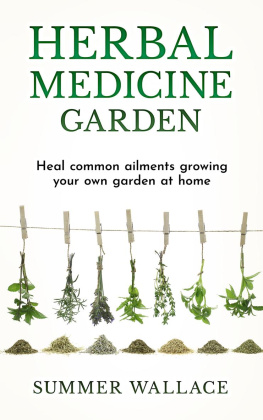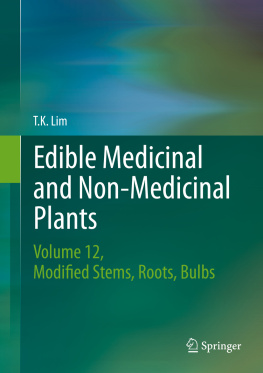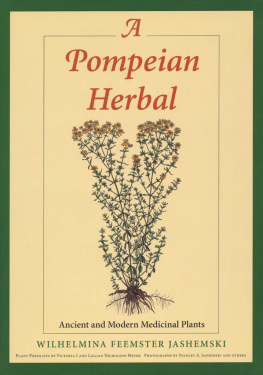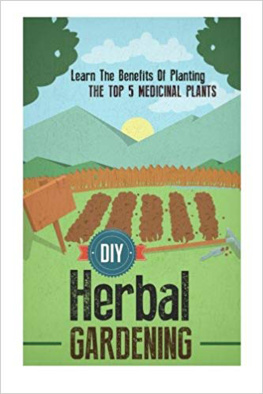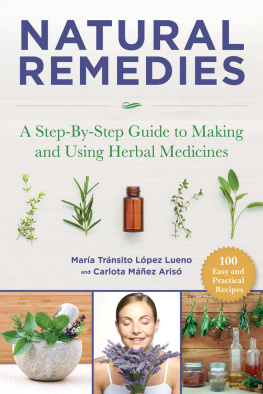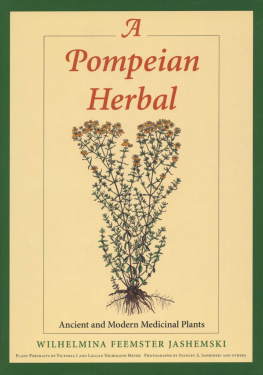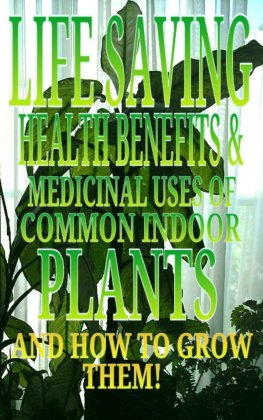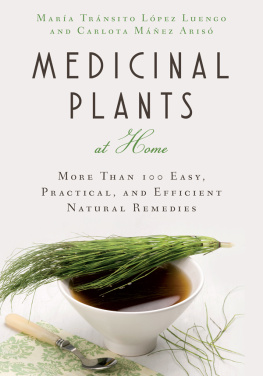Gardner - DIY Herbal Gardening: How To Grow The Top Medicinal Plants And Their Uses And Benefits
Here you can read online Gardner - DIY Herbal Gardening: How To Grow The Top Medicinal Plants And Their Uses And Benefits full text of the book (entire story) in english for free. Download pdf and epub, get meaning, cover and reviews about this ebook. year: 2014, genre: Children. Description of the work, (preface) as well as reviews are available. Best literature library LitArk.com created for fans of good reading and offers a wide selection of genres:
Romance novel
Science fiction
Adventure
Detective
Science
History
Home and family
Prose
Art
Politics
Computer
Non-fiction
Religion
Business
Children
Humor
Choose a favorite category and find really read worthwhile books. Enjoy immersion in the world of imagination, feel the emotions of the characters or learn something new for yourself, make an fascinating discovery.
DIY Herbal Gardening: How To Grow The Top Medicinal Plants And Their Uses And Benefits: summary, description and annotation
We offer to read an annotation, description, summary or preface (depends on what the author of the book "DIY Herbal Gardening: How To Grow The Top Medicinal Plants And Their Uses And Benefits" wrote himself). If you haven't found the necessary information about the book — write in the comments, we will try to find it.
DIY Herbal Gardening: How To Grow The Top Medicinal Plants And Their Uses And Benefits — read online for free the complete book (whole text) full work
Below is the text of the book, divided by pages. System saving the place of the last page read, allows you to conveniently read the book "DIY Herbal Gardening: How To Grow The Top Medicinal Plants And Their Uses And Benefits" online for free, without having to search again every time where you left off. Put a bookmark, and you can go to the page where you finished reading at any time.
Font size:
Interval:
Bookmark:
Copyright 2014 by Alex Gardner- All rights reserved.
No part of this publication may be reproduced in any way whatsoever. The author of this book does not dispense medical advice or prescribe the use of any technique as a form of treatment for physical, emotional, or medical problems without the advice of a physician, either directly or indirectly.
The information in this book reflects the authors opinions and is in no way intended to replace medical advice. Before starting the Paleo diet or any other diet, nutritional or exercise regime, it is important that you consult your physician to make sure it is appropriate for you. If you are not sure of any foods or exercises/workouts recommended, you should always consult your physicians advice. Any and all product names referenced within this book are the trademarks of their respective owners. None of these owners have sponsored, authorized, endorsed, or approved this book.
The author has made every effort to provide accurate information in the creation of this book. The author accepts no responsibility and offers no warranty for any damages or loss of any kind that might be incurred by the reader/user due to actions resulting from the use of the information in this book.
The user assumes complete responsibility for the use of the information in this text. The recipes included in this book are popular recipes and are not invented by author.
Table Of Contents
Are you tired of waiting for the seasons to change before you can savor the taste of fresh herbs and spices? Then the suggestion of growing an indoor herb garden is perfect! It's a win-win situation for sure!
The best part of it isyou don't need to know a thing about herbal gardens. Even if you have a black thumb and have killed off every plant you've ever ownedyou'll find herbs far easier. You'll save money too. Herbs are some of the most expensive produce you'll buy at the grocery store.
Let's get you started at having an herb garden whatever the weather! We will cover steps to growing an outdoor herb garden as well as an indoor garden in case you live in a palpable climate for them.
The Top Herbs
Chives, Mint, Oregano, Thyme and Rosemary are the most common used in cookery and they just so happen to be the best kinds to grow indoors. Like baked potatoes in the winter?
Then fresh chives are just a snip away. If you're a spaghetti sauce lover then imagine what transformation fresh oregano would make?
Getting the Herb Garden Started
The Basics
Most herbs grow great in pots. The aforementioned five favorites are just that kind. However; if you live in a warmer climate with full sun at least 4 hours a day, then consider a patio or outdoor patch as well.
Some herbs love to spread out and some grow like trees. The spray can reach 6-8 inches and a 4 foot circumference so outdoors may be best for some. Alternativelyyou may want to grow them in giant tree pots which also work if you have a sunny enclosed patio. Herb gardens are fun and versatile.
Four Components for a Successful Herb Garden
- Lots of Sunshine
- Good Potting Soil that Drains Sufficiently
- Herb Appropriate Fertilizer
- Appropriate Watering
An equally important element is positioning them for optimal effect. Herbs enjoy and thrive in sunny areas as long as they are never exposed to temperatures of more than 90 degrees.
But, there is a science to that which is very simple. Place them in an area that receives sun 4 hours and shade for the rest of the day. An easy way to ensure they are where they need to be is to check them every four hours in each spot.
For example from 8am until noon, then the next four hours and so on. It may actually take a little experimentation to get it right. If you really intend to have a fully indoor herb gardenyou may have to do it in a sun room or indoor patio to get full sun in a spot that will shade itself in the afternoon or just simply move them to a shadier area.
Once you've gotten this down, you're good to go.
Planting Your Herbs
Planting is easy. Here there are some guidelines for successful planting.
Plant Area
Needs to be between 1-4 feet. This depends solely on the plant itself and what they like.
Plant Type
Sage, Rosemary, Mint, Oregano and Marjoram like a good 4 foot range and no less than 3 feet.
Savory, Basil Thyme, Tarragon like a 2 foot range.
Cilantro, parsley, Chives and dill like a I foot range.
Preparing Soil
Now, the soil has to be treated much the same way whether it is indoor or outdoor. It just gets done on a smaller or larger scale depending on whether it's in pots indoors or outdoors in the ground.
Make sure you are turning the soil the aerate it. You can use a gardening fork or a hand aerator you can find in a gardening DIY shop. This creates room in the soil so the nutrients can be picked up by the roots and flourish the plant. It also allows the water to drain which is extremely important for herb gardens.
It is strongly suggested you put fertilizer which is appropriate for your herbs about one inch over the top and then incorporate it into the soil. This will take care of any drainage issues.
Planting The Garden
Find the most healthy and strong plants available
You'll want to give them a fighting chance through the possible root shock from replanting etc. It is a bit traumatizing to them to do this so you'll want to have a hardy plant to start with.
Watering is essential in the right amount and at the right time
Herbs can suffer from over watering just as much as under watering. If you over water you are lending an opportunity for root rot and diseases and growth issues. If you are under watering they will die of malnutrition and other aspects. So, the watering instructions are very simple.
Test Soil
Test the soil 1 inch deep below the surface for dryness. This tells you that it is appropriate to water. As long as it's wet at that 1 inch below the surface you have watered appropriately.
Timing the Watering
This is actually dependent on the climate you live in. If you live with humidity or in a particularly arid climate then the water will evaporate more readily.
This may take a while to figure out. The best thing you can do is to check it throughout the day for a while to get a good handle on when and how much you need to water.
The Harvest!
This is the best time of all! You get to plan exciting recipes for use everyday!
Cut your Herbs
Cutting herbs for use is like pruning a tree or a shrub. You don't just cut away! And leave the plant to fend for itself. You must cut 1/3 rd of the leaves as close to the intersection of the leaf as possible after the plant has reached 6-8 inches tall.
This way, they will regrow fast and you don't have to wait very long to use it again as well as having a nice healthy flourishing plant all year.
Plant Growth Differences
Different plants grow new leaves in different places. Some, will grow new leaves from the middle and some will grow from the outer edge. Once you watch your plants grow you'll get to see what their habits are.
Container Planting Herbs
As we said, we would cover container planting as well as ground planting for those that are die-hard indoor herb gardeners. This is a much easier way of planting that will save time and energy in digging holes in the ground.
The Difference Between Ground and Container Gardening:
The main difference is that plants just like being in the ground, after-all it's their natural state and they like to spread their roots out. Container plants need a bit more attention to watering and fertilization than their ground partners outside. But, it's easy and quite therapeutic.
Font size:
Interval:
Bookmark:
Similar books «DIY Herbal Gardening: How To Grow The Top Medicinal Plants And Their Uses And Benefits»
Look at similar books to DIY Herbal Gardening: How To Grow The Top Medicinal Plants And Their Uses And Benefits. We have selected literature similar in name and meaning in the hope of providing readers with more options to find new, interesting, not yet read works.
Discussion, reviews of the book DIY Herbal Gardening: How To Grow The Top Medicinal Plants And Their Uses And Benefits and just readers' own opinions. Leave your comments, write what you think about the work, its meaning or the main characters. Specify what exactly you liked and what you didn't like, and why you think so.

